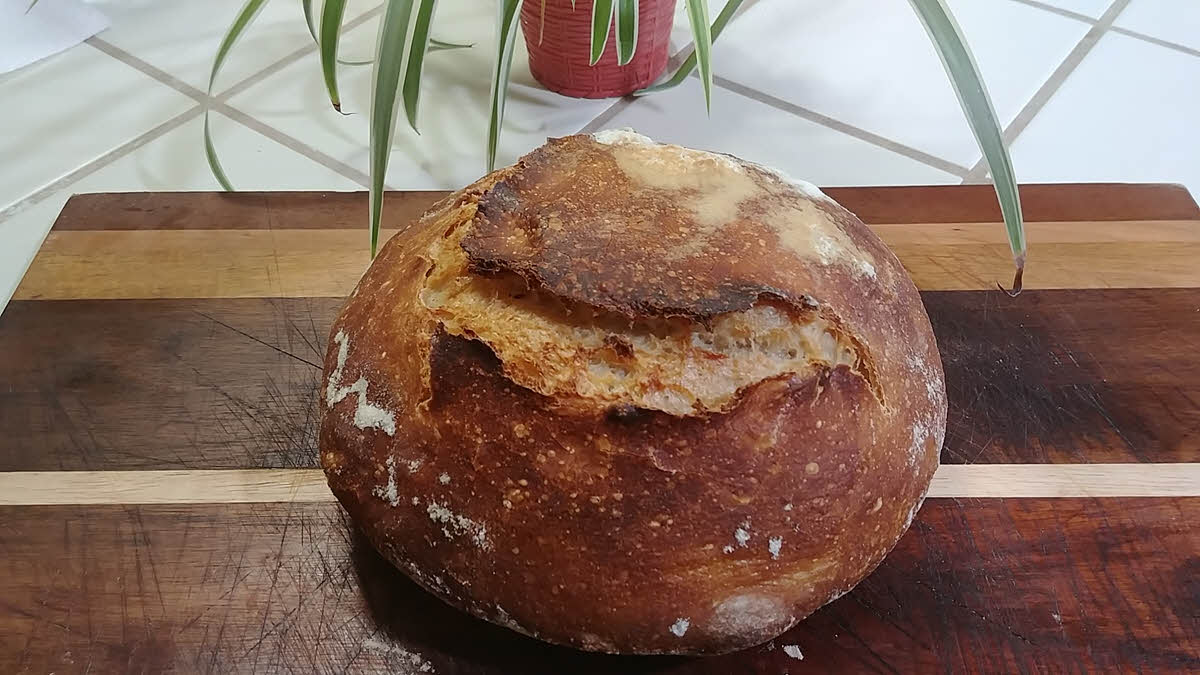Sourdough bread is made by the fermentation of dough using naturally occurring wild yeast in the environment. It has a mildly sour taste not present in most breads made with baker’s yeast. Bread made from wild yeast keeps particularly well (without preservatives). And of course it takes more effort but hey all good things in life require more effort, right?
| Preparation Time: | 1 day |
| Servings: | 1 round loaf |
| Difficulty: | Hard |
Ingredients
| UNBLEACHED all Purpose Flour | 2.5 cups |
| Sourdough starter at 100% hydration | 1/2 cup |
| Salt | 1.25 tsp |
| Warm Water 105F | 1 cup |
Method
- Combine starter, water and 1.5 cups of flour and mix vigorously for 1 minute so that no dry flour is left.
- Cover and rest for 4 hours at about 80 degrees fahrenheit (room temperature). At the end of 4 hours, it should have bubbles forming.
- Refrigerate overnight for at least 12 hours.
- Add remaining flour and salt and knead in stretch and fold actions for at least 5 minutes to form a silky smooth dough. Dough will be very wet.
- Let the dough rise in a covered bowl for at least 5 hours. It should have big visible air pockets in the dough in the end. During these 5 hours, deflate it gently after every hour on a floured surface and make 4 folds to make a packet.
- At the end of 5 hours, gently shape the dough without deflating using a little dry flour. Basically pull in the dough underneath and roll it on the surface to create surface tension.
- Grease a dutch oven or a pyrex bowl with cover and place the dough in it.
- Cover it and let it rise for 2 to 4 hours until its visibly puffed up.
- Preheat the oven to 425 degrees fahrenheit. Once the oven is hot, make a couple of 1 inch deep cuts in the dough and mist it with water lightly.
- Bake it in the oven with lid on for 30 minutes. After that take off the lid and bake for another 15 minutes for browning.
- Once it is browned to your liking, take out the dish from the oven. Open the lid and take out the bread and let it cool on the wire rack for at least 1 hour before cutting it.
- Sourdough bread is ready to be cut and served.
Notes:
- Making a bread using natural starter is the oldest form of making bread. This is how our ancestors made bread. Commercial yeast can’t match the complexity of natural fermentation because of all those flavor-producing bacteria milling about.
- You can get the starter from stores or you can make it yourself. It takes 7 to 10 days to make the starter.
- Always use unbleached all purpose flour for sourdough breads because the starter is natural, the chemicals in bleached flour may kill the starter.
- Baking the bread in pyrex dish makes it chewy. If you don’t want the bread to be chewy, bake it on a greased baking sheet uncovered.
- If you want your bread crispy, bake it on a pizza stone or pizza steel and let it cool in the oven itself with oven door open a couple of inches after it’s switched off.
- The longer you keep the dough after mixing, the sour it gets.
- It is better to underproof the bread instead of overproofing. Overproofing makes the bread hard. In bread baking, proofing means letting the dough rise.
- The hole structure of the bread is called the crumb of the bread. The more wildly inscribed and chaotic the hole structure, the better the bread. Why? Because such a structure indicates that the dough has been properly kneaded (aerated) and/or given the luxury of a long fermentation time, both of which lead to the development of the carbon-dioxide-gas bubbles that inflate the air pockets in the dough and allow for a light and tender loaf.
- The more wet the dough, the larger will be the holes in the crumb.
- Scoring is slashing the dough with a blade or a sharp knife to allow it to expand during baking. The purpose is primarily to control the direction in which the bread will expand during ‘oven spring.’
- In bread baking, the final burst of rising just after a loaf is put in the oven and before the crust hardens is called ‘oven spring’. This ‘oven spring’ is a good indicator of the crumb of your bread: more oven spring means a light and airy interior and little oven spring indicates a dense, compact crumb.
Summary

Recipe Name
Sourdough bread
Author Name
Ruchi Garg
Published On
Total Time
Average Rating




 Based on 4 Review(s)
Based on 4 Review(s)












